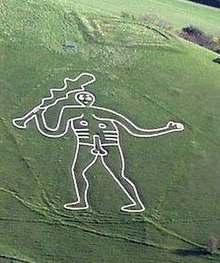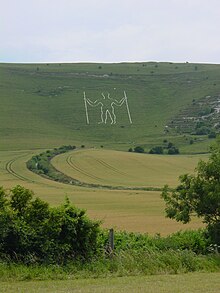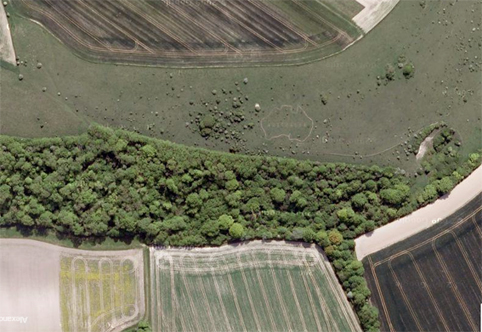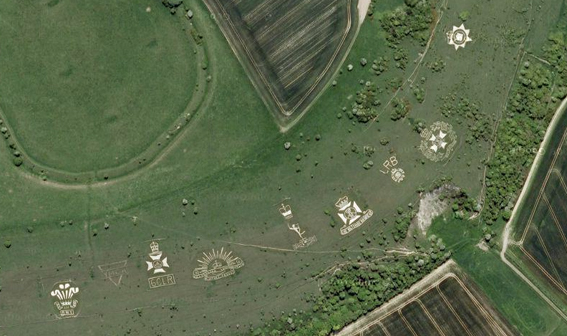You would think, with an abundance of hillside White Horses in Wiltshire, you wouldn’t be able to walk over a ridge or valley without falling over any type of chalk hill figure of the non-horse variety.
Sadly that’s not the case. Dorset boasts the great ‘Cerne Abbas Giant‘ (left), while East Sussex flaunts the ‘Long Man of Wilmington’ (right).
Here in Wiltshire, we’re sadly lacking. Thanks to our long Military history we have military badges and emblems and a few animals. The irony is that most of the chalk emblems were created during the First and Second World Wars by other nations to remind them of home. No prehistoric remains or markers are visible today.
Pterry the Pterodactyl

2012 marked the centenary year for Upavon golf club which has long been associated with the old RAF Upavon station (now British Army Headquarters called Trenchard Lines).
The RAF motif was a pterodactyl rising from rocks symbolising the station’s connection with the early days of flying, and also the close location to Stonehenge.
As a tribute to the close relationship, the golf club had with RAF station their centenary logo features a Pterodactyl. Pterry also looks on as a hill figure from hole 3 of the Upavon golf course. A fitting tribute indeed.
The Bulford Kiwi
The Bulford Kiwi is an immense drawing of a kiwi carved in the chalk on Beacon Hill above the military town of Bulford on the Salisbury Plain in Wiltshire. It was created by New Zealand soldiers awaiting repatriation following the end of World War I.

During World War II the Kiwi was camouflaged with leaf mould out of concerns that German bombers would use the Kiwi as a navigation marker during their raids over Britain. In 1948 the leaf mould was removed by local Boy Scouts and fresh chalk was added. The Scout troop subsequently renamed themselves in the Kiwi’s honour.

As of 2007, the Kiwi is maintained by the Ministry of Defence.
‘Australia’ in Compton Chamberlayne
During World War I there were thousands of Australian and Canadian troops encamped in the fields below the chalk downland before being shipped to France for combat.
Compton Chamberlayne burial ground has about 20 graves of Australian soldiers who died, believed to be of influenza, during their transit through the local camp. There is still today a field called ‘hospital’, previously the site of the military medical facility.
The only tangible sign of the previous occupation was the outline of Australia carved in the surface of the chalk downs to the south east of the village which was left to grass over in 2005. You can still see it via Google maps.
If you’d like to read more of its history, click here for a PDF by Cathy Sedgwick for the Wiltshire OPC project
The Fovant Badges
The Fovant Badges are a set of regimental badges cut into a chalk hill, in southwest Wiltshire. They were created by soldiers garrisoned nearby waiting to go to France during the First World War. The first badges were cut in 1916, and still today clearly visible from the A30 road which runs through the village.
After the outlines were cut into the grass-covered hillsides, they were refilled with chalk brought from a nearby slope, up to 50 tons per badge. The badges took an average fifty men six months to complete. Eight of the original twenty remain and are ‘scheduled ancient monuments’ recognised by the Imperial War Museum as war memorials. Further badges have been added more recently.
The annual cost of maintenance is currently approaching £32,000 plus VAT. The Fovant Badge Society holds an annual Drumhead Service which is attended by the Australian High Commissioner, local mayors and members of parliament. These services fund the upkeep of the badges but more donations are needed for the badges to survive into the future.
The Rising Sun badge
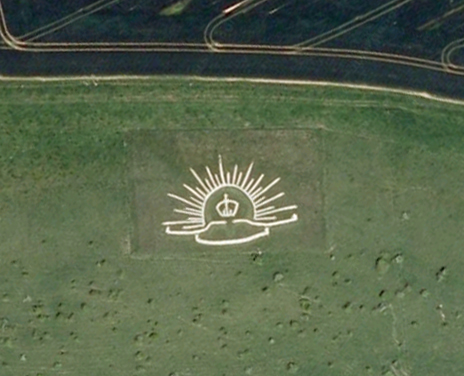
The badge is of the Australian Commonwealth Military Forces cut on a steep slope just by the A36, at the top of Lamb Down. The badge is fenced in and is of the same design as one cut at Fovant (above) although not nearly as detailed in its design.
Cut in 1916-1917 by Australian troops stationed at the local Codford and Sutton Veny military camps, the badge is based on the cap badge of the Australian Army. This design is also on the camp gates which has recently been acquired by the Warminster Historical Society and Dewey Museum, Warminster.
The then Australian Brigade Commander of the nearby Australian garrison would gaze out from the reading room at Stockton House and so came up with the idea of leaving his mark on the English countryside. His decision led to defaulters carving out a rising sun badge in the chalk on the hillside. The initial work on the badge was started by the 13th Training Battalion, Australian Imperial Forces (AIF). The badge was then embedded with green, brown and clear beer bottles to make it shine bronze like the badge worn on the Australian uniform. Maintaining the badge became the focus of punishment parades and as a result, the spur on which it is carved was affectionately known as Misery Hill by Australian troops.
The badge remained untouched until WW2 when it was covered over to prevent enemy aircraft using it as a navigation aid. After the war, it was uncovered however most of the glass had either washed away or sunk into the chalk below.
The outline of the badge remains to this day and due to the nature of the badge – chalk – it requires annual maintenance. Each year, members of the Australian Army stationed in England and the local community gather to refurbish the badge, as a memorial to the Australians who came and died in the two great conflicts.
– Text reproduced by kind permission of Dr Mark Hows, author of
The
For more in-depth information and pictures on Hill Figures outside of Wiltshire, please visit The Hillfigure Homepage
Lost Hill Figures
The Laverstock Panda

In the early hours of Sunday, January 26, 1969, a giant figure mysteriously appeared on a chalk hillside just outside Salisbury. A 55-foot tall panda’s head had emerged overnight.
Nobody knew who had created the mysterious chalk panda, or why. The Times newspaper speculated a connection to London Zoo, but nobody came forward. The only clue: the letters UCNW carved underneath. Did the panda represent the Union for Conservation of Nature and Wildlife?
Thirty years on, the mystery is laid to rest. The story begins a week before the panda’s appearance.
A student from Salisbury studying at the University College of North Wales has an idea. That night at the Student Union Bar he rounds up volunteers for his rag week scheme. A week later a dozen recruits meet up at a Salisbury pub. At midnight they hit the hill with spades and a grid plan.
For 6 hours they work in darkness. A 55-foot outline is cut and the turf stripped away to expose the underlying chalk. In the early hours of Sunday morning, passers-by gape at the 2,200-foot square hill figure.
The Laverstock Panda, the symbol of the UCNW rag week, had been created. The following year the figure was re-cut but to no avail. Today the Laverstock Panda is overgrown and no longer visible.
Read a PDF written by Linda for the Wiltshire OPC project

